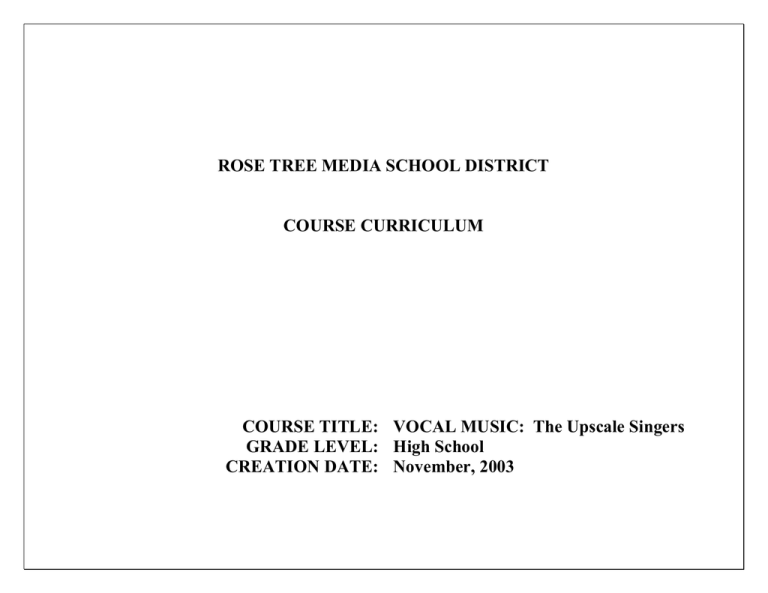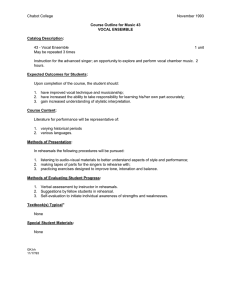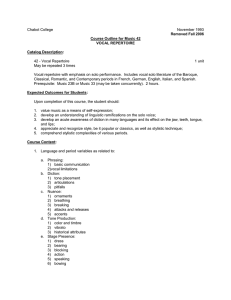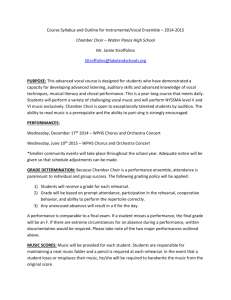ROSE TREE MEDIA SCHOOL DISTRICT COURSE CURRICULUM
advertisement

ROSE TREE MEDIA SCHOOL DISTRICT COURSE CURRICULUM COURSE TITLE: VOCAL MUSIC: The Upscale Singers GRADE LEVEL: High School CREATION DATE: November, 2003 Essential Question, Concept or Theme: I. Performing: All students perform independently and within an Approx. Time Allotment: ensemble using various textures and styles within the voicing of a well-balanced SSAA choir. PA Standards: PA 9.1, NS 1 Aligned Materials/ Benchmark/Skills Assessment Instructional Strategies Resources/Technology Materials Routinely provide a taped recording of him or Participate routinely in I. PERFORMING herself in the performance of vocal music from Essential Musicianship (A The students will: group sightsinging three to six minutes in length. The student is asked Comprehensive Choral exercises. Explore, describe and refine to use a rubric to identify characteristics for Method) Books 1,2,3 Sightsing as part of a the individual singing voice quality performance in terms of musical accuracy, By Emily Crocker and John formal assessment a through recording and vocal quality and expressiveness. Leavitt: Hal Leonard minimum of twice a listening to themselves on Identify by sound and be able to employ Corporation, 1995. year. tape. (1/9.1) International Phonetic Alphabet symbols for the Teacher generated materials: Complete notation Develop pure vowel pure vowels. rubrics, worksheets, quizzes, worksheets and placement. Identify by sight Perform with good breath control throughout critiques quizzes. and sound. his/her singing range and chart the development Mirrored wall in classroom Musically notate Integrate diaphragmatic of the singing range on the staff throughout the Individual hand-held mirrors his/her composed course of the year. breathing and extend the (100) warm-up exercise. Perform in a quartet of mixed voice parts with one Resources vocal range in an person on a part, twice a year for assessment Analyze a selection of Visiting Artists appropriate manner. purposes. twentieth-century Exchange concerts with other Sing, with accuracy, in Understand definitions and descriptions, and be music, identifying and choirs small ensembles with one able to identify aural samples of a variety of tone Field Trips describing the notation person on a part. (1/9) qualities. Graph changes in personal tone quality Choir Tours symbols used. Demonstrate well-developed as an ongoing process throughout the year. Technology Participate routinely in ensemble skills. (1/9.1) Participate routinely in rotating sectional Pianistic/Sequencing Keyboard rotating sectional Sing with expression and rehearsals. Multi Track Tape Player rehearsals. technical accuracy a large Participate in 4 annual mandatory Microphones with directional and varied repertoire of concerts: pickup (6) 1. Winter Concert vocal songs performed from CD Burner 2. December In-School Concert memory. (1/9.1) Blank Compact Disks (3 per 3. December Concert for Visiting Sing music written in 3, 4, 5 student) Elementary Students and 6 parts, with and Tape recorders (a minimum of 4. Spring Concert without accompaniment. 25) Participate in School/Public/Community concerts, (1/9.1) Blank cassette tapes (2 per in Choral Festivals, Adjudications, and Master Classes as scheduled. VOCAL MUSIC: The Upscale Singers Page 1 student) Audio/Visual Tapes -1- November, 2003 Essential Question, Concept or Theme: I. Performing: All students perform independently and within an ensemble using various textures and styles within the voicing of a well-balanced SSAA choir. PA Standards: PA 9.1, NS 1 Adaptations/Inclusion Techniques One on One vocal sectional Recorded voice parts for repertoire Adapted rubrics/worksheets/quizzes Teacher Aide Private lessons VOCAL MUSIC: The Upscale Singers Enrichment Strategies Sectional rehearsals Visiting artists Festivals Community performances Concert tours Choir Tours Field trips Adjudications Private lessons Technology/Electronic resources Page 2 Remediation Strategies One on One vocal sectional Recorded voice parts for repertoire Adapted rubrics/worksheets/quizzes Teacher Aide Private lessons Peer Coaching Approx. Time Allotment: Multicultural/Interdisciplinary Connection Authentic repertoire from multicultural composers Visiting Artists Students with diverse backgrounds Audio/Visual tapes Interdisciplinary Strands: Foreign Language, Language Arts, Social Studies, Mathematics, Physics -2- November, 2003 Essential Question, Concept or Theme: II. Listening/Responding: All students critically assess music performances that reflect a wide diversity of peoples, styles and times. The student will apply data from these assessments to their personal and ensemble performance of vocal/choral music. Approx. Time Allotment: PA Standards: PA 9.2, 9.3, 9.4, NS 6, 7, 8, 9 Benchmark/Skills II. LISTENING/RESPONDING The students will: Demonstrate the ability to perceive and remember music events by describing in detail significant events occurring in a given aural example. (6/9.3, 9.4) Demonstrate extensive knowledge of the technical vocabulary of music. (6/9.3/9.4) Identify and explain compositional devices and techniques used to provide unity and variety and tension and release in a choral/vocal work and give examples of other works that make similar uses of these devices and techniques. (6/9.3/9.4) Develop specific criteria for making informed, critical evaluations of the quality and effectiveness of choral/vocal performances, compositions, arrangements, and improvisations and apply the criteria in their personal participation in music. (7/9.3,9.4) Evaluate a choral/vocal performance, composition, arrangement, or improvisation by comparing it to similar or exemplary models. (7/9.3, 9.4) Evaluate a given choral/vocal work in terms of its aesthetic qualities and VOCAL MUSIC: The Upscale Singers Assessment Identify and explain compositional devices and techniques used to provide unity and variety and tension and release in a choral/vocal work currently being prepared and give examples of other works that make similar uses of these devices and techniques. `The student will be asked to construct a rubric illustrating these devices/techniques and the repertoire’s relation to the compositional devices. Identify music terminology by sight, by listening and by demonstrating vocally. Identify and explain compositional devices and techniques used to provide unity and variety and tension and release in a choral/vocal work currently being prepared and give examples of other works that make similar uses of these devices and techniques. `The student will be asked to construct a rubric illustrating these devices/techniques and the repertoire’s relation to the compositional devices. Provide a taped recording of him or herself in the performance of vocal music from three to six minutes in length. The student is asked to listen to the recording, and write an evaluation on the performance on the basis of its (1) technical accuracy, (2) expressive or musical qualities, and (3) overall effectiveness. (The assessment is based not on the quality of the performance but rather on the student’s ability to evaluate the performance.) Evaluate a school choral performance of a selection, comparing the performance to a recorded or live PMEA Choral Festival or college performance of the same or similar selection. Page 3 Aligned Materials/ Resources/Technology Materials Essential Musicianship (A Comprehensive Choral Method) Books 1,2,3 By Emily Crocker and John Leavitt: Hal Leonard Corporation, 1995. Teacher generated materials: rubrics, worksheets, quizzes, critiques Mirrored wall in classroom Individual hand-held mirrors (100) Resources Visiting Artists Exchange concerts with other choirs Field Trips Choir Tours Technology Pianistic/Sequencing Keyboard Multi Track Tape Player Microphones with directional pickup (6) CD Burner Blank Compact Disks (3 per student) Tape recorders (a Instructional Strategies -3- Vocally imitate various genres, styles and cultures of choral/vocal music through the use of clinicians, in-house teachers and CDs Demonstrate the usage of music terminology contained in the repertoire. Listen to professional recordings of vocal music of various genres, styles and cultures. Routinely view/listen to a video of the ensemble’s performance using a rubric to evaluate the quality of musicianship and stage performance. Attend concerts, professional and non-professional, comparing and contrasting the quality of the school’s ensemble and the individual’s vocal technique through the use of a rubric. Routinely critique the ensemble’s performance using a rubric to evaluate the quality of musicianship and stage performance. Listen to professional recordings of vocal music of various genres, styles and cultures. Categorize the current repertoire of choral selections based on historical period, composer, style, November, 2003 Essential Question, Concept or Theme: II. Listening/Responding: All students critically assess music performances that reflect a wide diversity of peoples, styles and times. The student will apply data from these assessments to their personal and ensemble performance of vocal/choral music. Approx. Time Allotment: PA Standards: PA 9.2, 9.3, 9.4, NS 6, 7, 8, 9 Benchmark/Skills explain the musical means it uses to make it unique, interesting and expressive. (7/9.3, 9.4) Analyze aural examples of a varied repertoire of choral/vocal music, representing diverse genres and cultures, by describing the uses of elements of music and expressive devices. (6/9.3/9.4) Compare characteristics of the choral/vocal arts with other arts within a particular historical period or style and cite examples from various cultures. (8/9.2) Explain ways in which the principles and subject matter of various disciplines outside the arts are with those of choral/vocal music. (8/9.2) Classify by genre or style and by historical period or culture unfamiliar but representative aural examples of choral/vocal music and explain the reasoning behind their classifications. (9/9.2) Identify and describe music genres or styles that show influence of two or more cultural traditions, identify the cultural source of each influence, and trace the historical conditions that produced the synthesis of influences. (9/9.2) VOCAL MUSIC: The Upscale Singers Assessment Evaluate a school choral performance based on the quality of musicianship and stage performance. Describe musical characteristics/elements of music and expressive devices that make certain songs appropriate for specific situations. Aligned Materials/ Resources/Technology minimum of 25) Blank cassette tapes (2 per student) Audio/Visual Tapes Instructional Strategies Critique choral/vocal performances of varying genres based on a rubric and a set of openended questions. Analyze works in two or more arts based on the same event or phenomenon. In groups, the students will present aurally how the elements of the various arts are used to convey the same specific meanings or feelings and cite two examples in each work. Attention should also be given to the creators, performers, and other professionals involved in the production and presentation of these arts, comparing and contrasting their roles. This is most effective when the choral literature being currently taught can be used as one of the examples. Evaluate, through the use of a rubric, the historical period, genre and style of each musical selection being taught that semester. Analyze representative works that show the influence of two or more cultural traditions, identify the cultural source of each influence and trace the historical conditions that produced the synthesis of influences. Use current or very similar repertoire. The analysis can be presented aurally or through the use of a written paper or a poster/flow chart. Page 4 -4- genre and form. Compare and contrast choral/vocal masterworks to other forms of art. Participate in Master Classes conducted by artists of various genres, styles and cultures. Compare and contrast choral/vocal masterworks to other forms of art. November, 2003 Essential Question, Concept or Theme: II. Listening/Responding: All students critically assess music performances that reflect a wide diversity of peoples, styles and times. The student will apply data from these assessments to their personal and ensemble performance of vocal/choral music. PA Standards: PA 9.2, 9.3, 9.4, NS 6, 7, 8, 9 Adaptations/Inclusion Techniques Approx. Time Allotment: One on One vocal sectional Recorded voice parts for repertoire Adapted rubrics/worksheets/quizzes Teacher Aide Private lessons VOCAL MUSIC: The Upscale Singers Enrichment Strategies Sectional rehearsals Visiting artists Festivals Community performances Concert tours Choir Tours Field trips Adjudications Private lessons Technology/Electronic resources Page 5 Remediation Strategies One on One vocal sectional Recorded voice parts for repertoire Adapted rubrics/worksheets/quizzes Teacher Aide Private lessons Multicultural/Interdisciplinary Connection Authentic repertoire from multicultural composers Visiting Artists Students with diverse backgrounds Audio/Visual tapes Interdisciplinary Strands: Foreign Language, Language Arts, Social Studies, Mathematics, Physics -5- November, 2003 Essential Question, Concept or Theme: III. Creating: Students manipulate music entities to compose Approx. Time Allotment: original music ideas. These ideas are developed and realized through personal and ensemble performance. PA Standards: PA 9.1, NS 3, 4 Aligned Materials/ Benchmark/Skills Assessment Instructional Strategies Resources/Technology Materials III. CREATING Compose a vocal warm-up Teach the choir/choir The students will: that directly enhances an Essential Musicianship (A section the original warm-up Compose an original vocal warmarea of work within a Comprehensive Choral Method) composed for the selected up that enhances a technique selected piece of the current Books 1,2,3 piece of repertoire. required in one selection of the repertoire. By Emily Crocker and John Listen to songs that use current repertoire. (4/9.1) Leavitt: Hal Leonard Corporation, improvisation. Improvise vocally over a short familiar melody with 1995. Improvise stylistically appropriate Practice improvising within harmonizing parts in a variety of clearly implied chords. The Teacher generated materials: the choir setting over a styles. (4/9.1) student is given one minute rubrics, worksheets, quizzes, pentatonic or major/minor to prepare, but may not sing critiques scale progression. Improvise rhythmic and melodic aloud. variations on given pentatonic Identify the twelve-bar blues Mirrored wall in classroom melodies and melodies in major progression by sight and Improvise a rhythm or Individual hand-held mirrors (100) and minor keys. (3/9.1) melody over a pentatonic or Resources sound and produce an major/minor chord improvisation within the Improvise original melodies in a Visiting Artists progression. The student is choir setting for a twelvevariety of styles, over given chord Exchange concerts with other given one minute to prepare, bar blues progression. progressions, each in a consistent choirs but may not sing aloud. style, meter, and tonality. (3/9.1) Field Trips Improvise a melody to a Choir Tours twelve-bar blues or another Technology given progression. The Pianistic/Sequencing Keyboard student is given one minute Multi Track Tape Player to prepare, but may not sing Microphones with directional aloud. pickup (6) CD Burner Blank Compact Disks (3 per student) Tape recorders (a minimum of 25) Blank cassette tapes (2 per student) Audio/Visual Tapes VOCAL MUSIC: The Upscale Singers Page 6 -6- November, 2003 Essential Question, Concept or Theme: III. Creating: Students manipulate music entities to compose original music ideas. These ideas are developed and realized through personal and ensemble performance. PA Standards: PA 9.1, NS 3, 4 Adaptations/Inclusion Techniques One on One vocal sectional Recorded voice parts for repertoire Adapted rubrics/worksheets/quizzes Teacher Aide Private lessons VOCAL MUSIC: The Upscale Singers Enrichment Strategies Sectional rehearsals Visiting artists Festivals Community performances Concert tours Choir Tours Field trips Adjudications Private lessons Technology/Electronic resources Page 7 Remediation Strategies One on One vocal sectional Recorded voice parts for repertoire Adapted rubrics/worksheets/quizzes Teacher Aide Private lessons Approx. Time Allotment: Multicultural/Interdisciplinary Connection Authentic repertoire from multicultural composers Visiting Artists Students with diverse backgrounds Audio/Visual tapes Interdisciplinary Strands: Foreign Language, Language Arts, Social Studies, Mathematics, Physics -7- November, 2003 Essential Question, Concept or Theme: IV. Reading and Notating: All students combine music reading and writing skills and competencies in their performance medium, alone and within an ensemble. PA Standards: PA 9.1, 9.3, 9.4, NS 1, 4, 5, 6 Aligned Materials/ Benchmark/Skills Assessment Resources/Technology IV. READING AND NOTATING Participate routinely in Materials The students will: group sightsinging Essential Musicianship (A Demonstrate the ability to read a exercises. Comprehensive Choral Method) vocal score of up to 8 staves by Books 1,2,3 Sightsing as part of a describing how the elements of formal assessment a By Emily Crocker and John music are used and explaining all minimum of twice a Leavitt: Hal Leonard Corporation, transpositions and clefts. (1/9.1, year. 1995. 5/9.1) Complete notation Teacher generated materials: Sight-read accurately and worksheets and rubrics, worksheets, quizzes, expressively music with a level of quizzes. critiques difficulty of 4, on a scale of 1 to 6. Musically notate Mirrored wall in classroom (5/9.1) his/her composed Individual hand-held mirrors (100) Demonstrate extensive knowledge warm-up exercise. Resources of the technical vocabulary of Analyze a selection of Visiting Artists music. (6/9.3, 9.4) twentieth-century Exchange concerts with other Write an original vocal warm-up. music, identifying and choirs (5/9.1) describing the notation Field Trips symbols used. Interpret nonstandard notation Choir Tours symbols used by twentieth-century Technology composers. Pianistic/Sequencing Keyboard Multi Track Tape Player Microphones with directional pickup (6) CD Burner Blank Compact Disks (3 per student) Tape recorders (a minimum of 25) Blank cassette tapes (2 per student) Audio/Visual Tapes VOCAL MUSIC: The Upscale Singers Page 8 Approx. Time Allotment: Instructional Strategies -8- Sing selected repertoire, identifying all notation and elements of music used. Routinely sightsing standard repertoire with accuracy. Articulate the definition of the technical vocabulary for all music in the current repertoire identifying all notation and elements of music used. Teach the composed warm-up. Using a selection of contemporary repertoire, write 4-8 bars of nonstandard contemporary notation and be able to explain its meaning. November, 2003 Essential Question, Concept or Theme: IV. Reading and Notating: All students combine music reading and writing skills and competencies in their performance medium, alone and within an ensemble. PA Standards: PA 9.1, 9.3, 9.4, NS 1, 4, 5, 6 Adaptations/Inclusion Techniques One on One vocal sectional Recorded voice parts for repertoire Adapted rubrics/worksheets/quizzes Teacher Aides Private lessons VOCAL MUSIC: The Upscale Singers Enrichment Strategies Sectional rehearsals Visiting artists Festivals Community performances Concert tours Choir Tours Field trips Adjudications Private lessons Technology/Electronic resources Page 9 Approx. Time Allotment: Multicultural/Interdisciplinary Connection One on One vocal sectional Authentic repertoire from multicultural composers Recorded voice parts for repertoire Visiting Artists Adapted Students with diverse rubrics/worksheets/quizzes backgrounds Teacher Aides Audio/Visual tapes Private lessons Interdisciplinary Strands: Foreign Language, Language Arts, Social Studies, Mathematics, Physics Remediation Strategies -9- November, 2003





